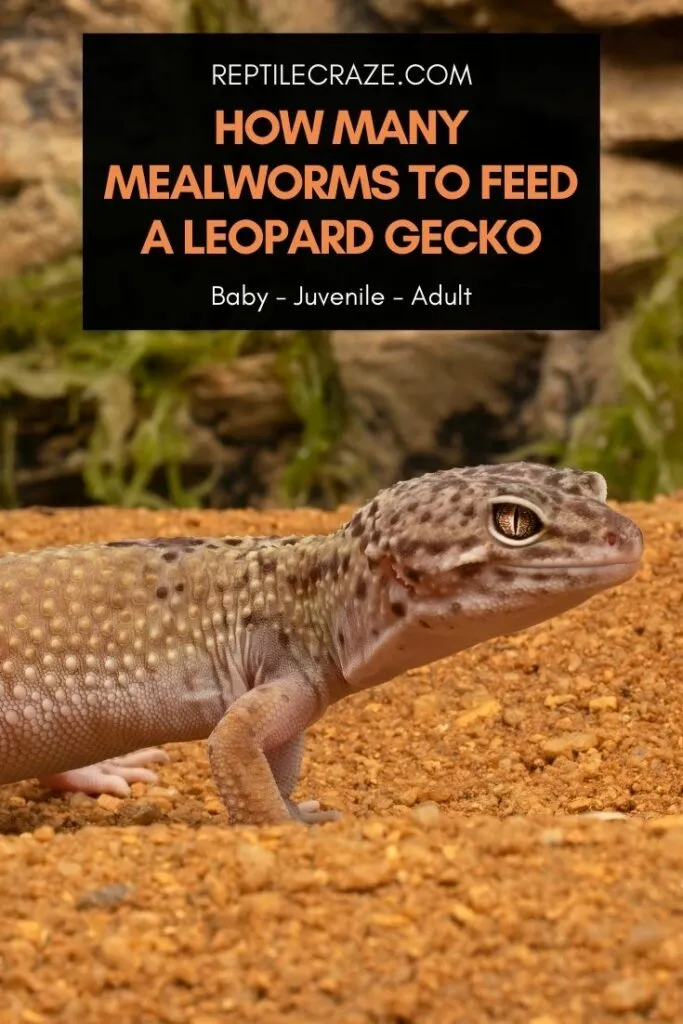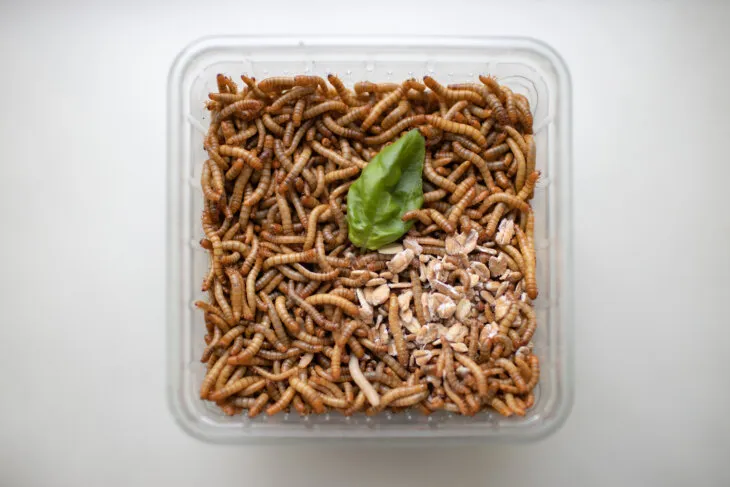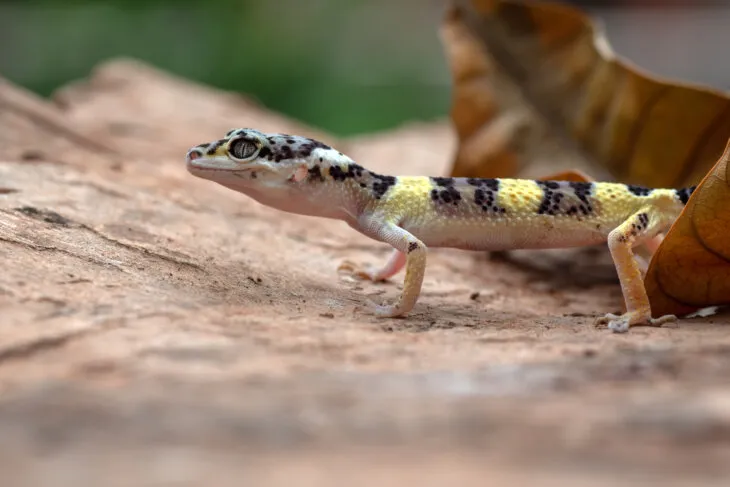
Mealworms (Tenebrio molitor) are often used as staple feeder insects for Leopard Geckos (Eublepharis macularius). But, Leopard Geckos need variation to get the optimum intake of nutrients. Mealworms alone are not an ideal diet for your pet. So, how many mealworms should you feed your Leopard Gecko?
Mealworms can be fed often, as part of a varied staple diet, but should not make up the bulk of the diet. Baby Leopard Geckos could eat 2 small mealworms daily, alongside other staple feeder insects. Adults could eat 2-3 large mealworms every 3-4 days alongside other staple feeder insects.
That’s the basic answer, but how many mealworms you feed can be affected by the health and size of your Leopard Gecko. Read on to learn more about how many mealworms to feed your Leopard Gecko.
Table of Contents
You Can Feed Mealworms Often As Part Of A Varied Diet
There is a lot of debate in the Leopard Gecko enthusiast world about how suitable mealworms are as staple
We believe that mealworms are acceptable to feed frequently. But, they should be the lesser part of a varied staple diet. The problem occurs when Leopard Geckos owners feed their pets with only mealworms.
This will not meet the nutritional needs of your pet, nor stimulate them mentally or physically to hunt.
Find out more about why we believe you should feed mealworms to your Leopard Gecko in our definitive guide.
You can see from the nutritional table below, that mealworms have a fairly good amount of protein, comparable to crickets. They offer fairly little moisture.
Their calcium to phosphorus ratio is better than crickets but worse than dubia roaches.
The amount of fat they contain is middling. They are not a fatty treat like wax worms, a larval feeder, but are not as low in fat as crickets.
Nutritional Values Of Mealworms Compared With Common Feeder Insects
| Meal Worms | Crickets | Dubia Roaches | Wax Worms | |
| Moisture | 66% | 73% | 65% | 62% |
| Protein | 18% | 18% | 21% | 14% |
| Fat | 10% | 6% | 9% | 18% |
| Fiber | 2% | 2% | 1% | 3% |
| Ca:P Ratio | 1:7 | 1:9 | 1:3 | 1:7 |
How Many Mealworms Should You Feed Your Adult Leopard Geckos?
Adult Leopard Geckos do not need to eat every day. From the age of 12 months and over, they should usually be fed around 3 times per week.
As mentioned above, it is a good idea to vary what you feed. This could be every meal, if you have a large collection of Leopard Geckos and are therefore able to store a variety of feeder insects at the same time.
However, for many owners, this is not possible. Therefore, you may be feeding mealworms and dubia roaches (click here for our guide) one week, then crickets and black soldier fly larvae (click here for our guide) the next.
Below is an example feeding schedule that you might use to feed mealworms.
| Age | How often to feed | How many mealworms to feed if only giving mealworms | Example of a mixed meal |
| Juvenile 4 to 12 months | Every other day (slow transition from everyday feeding to adult feeding schedule) | 5-7 medium mealworms | 2 medium mealworms +4 dubia roaches |
| Adult 12+ months | Every 3-4 days | 6 – 8 larger mealworms | 2 large mealworms +5 dubia roaches |
It can be difficult to work out exactly how much
You also need to weigh them and examine their body condition frequently, and record that too.
Over time, if you notice that your Leopard Gecko is becoming over or underweight, you can refer to what you were feeding them at that time, and learn what should be changed.
Every Leopard Gecko is a little different, and feeder insects can vary in their nutritional value due to many factors.
Starting with an approximate prescribed feeding plan is great, but monitoring body condition is the only way to truly understand whether your Leopard Gecko needs more or fewer mealworms.
How Many Mealworms Should You Feed Your Baby Leopard Geckos?
Baby Leopard Geckos need to be fed daily. During this time, they are growing fast, and have a lot of need for protein and calcium. They also need calories.
However, they do not benefit from having calorific, fatty feeder insects unless they are severely underweight and you have consulted the vet.
Ideal foods for baby Leopard Geckos include dubia roaches, small crickets, buffalo worms (here is our guide), small mealworms, and black soldier fly larvae.
Here is an example feeding schedule for a baby Leopard Gecko, but there are many variations that you could offer.
| Age | How often to feed | How many mealworms to feed if only giving mealworms | Example of a mixed meal |
| Baby 0 to 4 months | Every day (After 4 months, begin to punctuate the week with days off, until around 6 months, when they should eat every other day) | 5-7 small mealworms | 2 small mealworms +4 tiny crickets |
Again, monitoring the weight, size, and body condition of your baby Leopard Gecko is very important. Compare their growth to the expected development, and refer to your records of the
This is the best way to determine whether you need to feed more or fewer mealworms.
What Size Mealworm Is Right For Your Leopard Gecko?
The right size of any feeder insect can be determined by looking at the space between your Leopard Gecko’s eyes. This space indicates the approximate width of their throat.
If the insect is wider than this, it may block the digestive tract, causing choking, or impaction.
It is very important to only offer feeder insects that are smaller than the width between your pet’s eyes. With mealworms, this is fairly easy, seeing as they are slim in girth.
But, you should also look at the length too. A very small mealworm is around 0.25 to 0.5 of an inch long. These are suitable for baby Leopard Geckos. The largest mealworms are called giant mealworms. These can reach up to 1.25 inches long.
Learn more about whether your Leopard Gecko can eat giant mealworms in our feature article.
Mealworms come in a range of sizes, and you can sometimes specifically order a certain size of mealworm from the supplier. This will help ensure you have plenty available that are suitable for your pet at their current growth phase. But remember, the mealworms will continue to grow too!

Your Leopard Gecko Needs More Mealworms If They Are Laying Eggs
When laying eggs, or preparing to lay eggs, your Leopard Gecko has a much greater need for protein and calcium. Therefore she needs more
If she does not get enough calcium, she will draw what she needs from her own skeleton. This puts her at great risk from metabolic bone disease, which can be damaging and fatal.
It is very important to ensure that you dust the mealworms with calcium powder before feeding them, to improve the calcium to phosphorus ratio.
During this time, it is very important to increase her calories using many different feeder insects.
Good suggestions are black soldier fly larvae and dubia roaches, both of which have better calcium to phosphorus ratios. However, the high protein content of mealworms is also beneficial.
Your Leopard Gecko Needs More Mealworms If They Are Malnourished
Malnourished Leopard Geckos may be underweight or lacking certain nutrients. Malnourished Leopard Geckos need more
Underweight Leopard Geckos will characteristically have thin tails that are thinner than the width of their neck. They may have concave (inward) curves to their body that should be convex (outward).
An adult under 40 grams in weight is underweight.

Mealworms can be a part of a treatment plan. They need to be given as part of a varied diet. If your Leopard Gecko is underweight or malnourished, consult your vet.
If your Leopard Gecko is underweight due to suffering from hepatic lipidosis, then the treatment diet needed will be different.
However, an underweight Leopard Gecko that simply needs more
Don’t forget to gut load and dust insects to deliver the optimum vitamins and minerals.
Your Leopard Gecko Needs More Mealworms If They Have Dropped Their Tail
Leopard Geckos can drop their tails as part of a defensive mechanism against predators. Regrowing the tail takes a massive amount of energy and protein. New tails tend to hold more fat.
To regrow the tail without the rest of their body suffering, your Leopard Gecko will need more calories and more protein. Mealworms are a good choice, as they have high protein levels and medium fat levels.
Increase your pet’s mealworm intake and give a few extra fatty treats to help them regrow the tail (we explain more on what to do if your leo dropped its tail here).
Remember though, to keep everything in balance and to dust your feeder insects.
Is It Possible To Overfeed Mealworms To Your Leopard Gecko?
Yes, it is possible to overfeed mealworms to your Leopard Gecko. This could either occur by overfeeding mealworms without any diversity in the diet, or by feeding drastically more than the caloric needs of your pet.
We have discussed the importance of feeding different types of feeder insects. If you overfeed mealworms without introducing other foods, your Leopard Geckos will end up having an imbalanced calcium to phosphorus ratio.
This could cause metabolic bone disease.
Leopard Geckos are generally fairly good at not overeating too drastically. However, they still should not be given free reign. Mealworms have more fat than other staple feeder insects.
Monitor how many mealworms they eat, and record it, as discussed above. Don’t feed them too much.
Overeating in the short term could cause an impaction. Impaction occurs when a bolus of
Impaction is very painful, and it also causes constipation, further illnesses and potentially death.
Overfeeding chronically can lead to obesity. Obesity causes many related illnesses. One of the most prevalent is hepatic lipidosis, or fatty liver disorder.
Hepatic lipidosis occurs when chronic overfeeding causes fat to build up in the body until it overwhelms the liver. Liver function shuts down, and your Leopard Gecko will begin to lose weight drastically.
To avoid these issues, limit how many mealworms you offer by following a feeding regime. Monitor your Leopard Gecko’s body condition by measuring and weighing them.
This way, you will avoid causing illness by overfeeding mealworms.
Can Mealworms Cause Impaction?
We have already established in this article that overfeeding mealworms can cause a number of different health complaints.
But overfeeding mealworms is more likely to cause impaction than overfeeding with some other types of insects, such as crickets or silkworms.
Mealworms are more likely to cause compaction due to their harder chitin shells, which are indigestible. Usually, if you are feeding a limited amount of mealworms, and selecting small enough mealworms, this is nothing to worry about.
You can reduce the risk of impaction from mealworms by selecting whiter mealworms. These have recently shed, and are softer and more easily digestible.
Also, ensure that you deliver mealworms on smooth surfaces such as a rock, dish, or by hand. This will prevent impaction from ingesting substrates like sand.
Our team has put together a detailed guide, addressing the risk of Leopard Gecko getting impacted from mealworms. Click the link to check it out.
- Enchi Ball Python: A Unique and Stunning Morph of Python regius - March 27, 2025
- Emerald Tree Monitor: The Enigmatic Green Guardian of the Rainforest - March 26, 2025
- The Egyptian Cobra (Naja haje): A Fascinating Serpent - March 25, 2025
